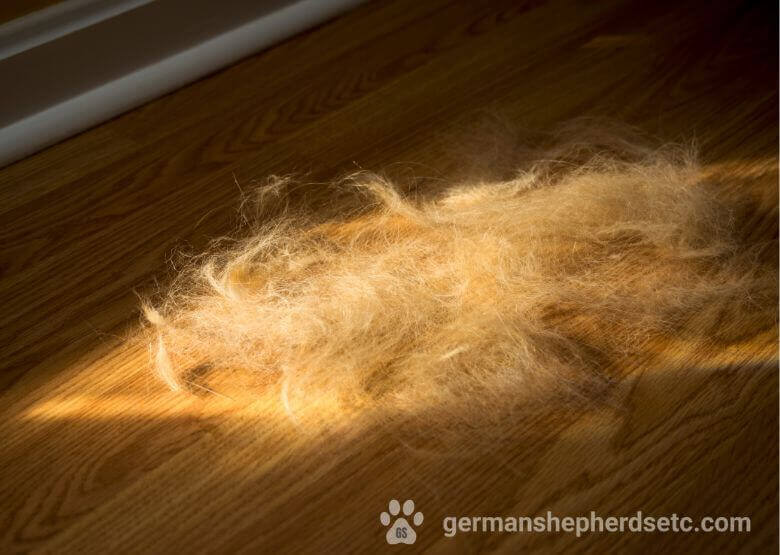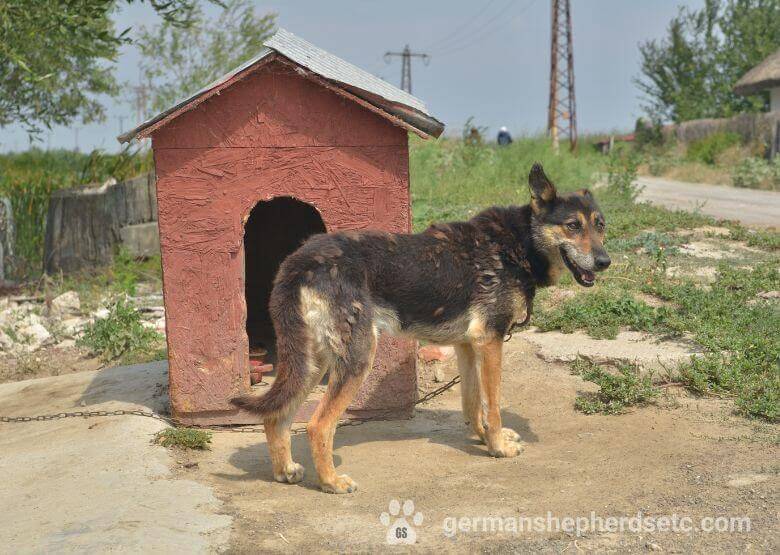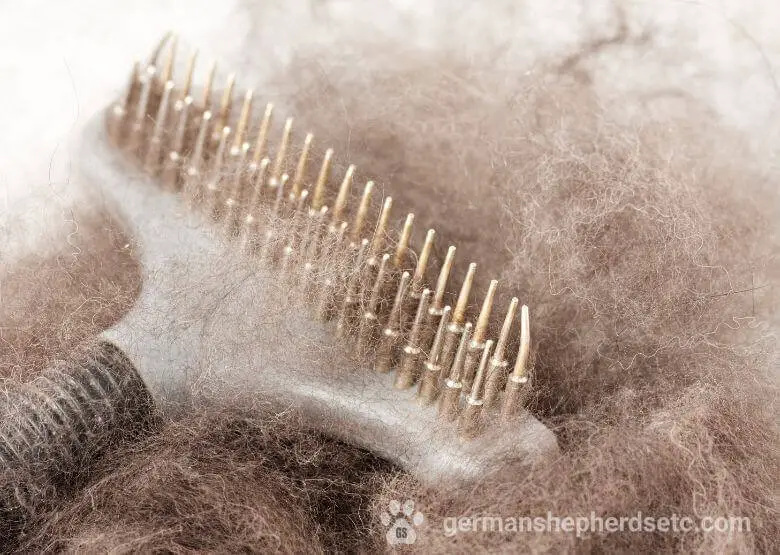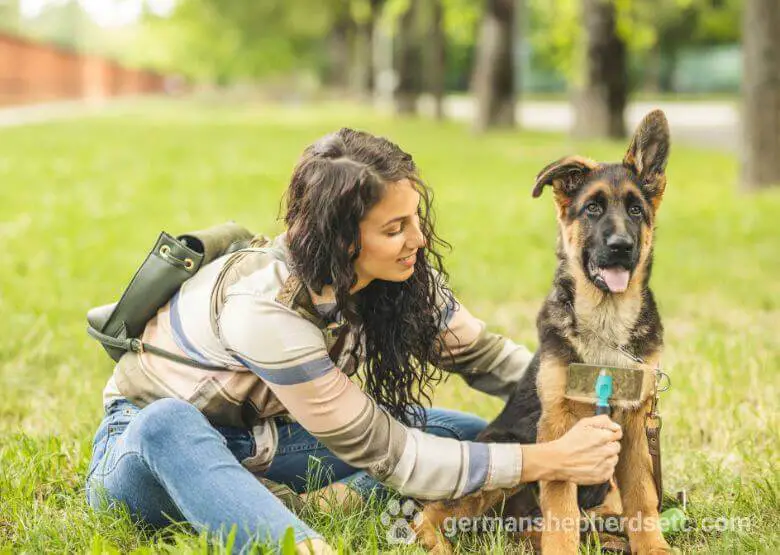Table of Contents
You love your German Shepherd dog very much, don’t you? However, there are times when all your household items, furniture, and clothing are covered with the dog’s fur. You may start worrying whether everything is OK with your pet and what you can do to diminish this shedding. If you are still looking for appropriate solutions, this article is right for you.
German Shepherd Shedding Is a Natural Process
Therefore, how much does a German Shepherd shed? The truth is that your doggy is a heavy shedder, and it is a natural process. You cannot stop it completely because these dogs shed all year round, especially in spring and autumn when they blow the fur. This process helps the animal to renew the coat, making it more sustainable to changing temperatures and weather conditions. It also helps avoid tangling and looking dull and unhealthy.
However, you can control this process and even reduce it to some extent with proper grooming. In addition, you can ensure that your dog is healthy and properly cared for. If you notice excess shedding, and the skin gets dandruff or becomes immensely dry, it may be a sign of health problems. Changing the grooming schedule is only the first step. If the condition does not improve, you should talk to your vet.
Why Are German Shepherds Such Heavy Shedders?
All animals shed seasonally, and all dogs do it. Though, German Shepherds are often called ‘German shedders’ because they can do it excessively throughout their lives. Most GSDs are double-coated. These two layers are different and serve different purposes. To function properly, they need to change in various intensities.
The outer coat is a top layer. The hairs are thick here, and they protect your dog against dirt, ticks, and fleas. This layer sheds every day. The intensity depends on the animal’s diet, age, size, and health condition.
The inner layer consists of soft fur of medium length. Its purpose is to keep the dog resistant to moisture and cold. This layer sheds in spring and autumn. This process is called ‘blowing’. The dog throws down the fur at once to get it ready for the change of seasons. It lasts for several days up to two weeks.
German Shepherd shedding is natural, and it is a continuous process in a healthy dog, so you don’t need to worry about its health. Your worries may concern the excessive shedding and the overall state of your furniture and belongings that are difficult to clean off all this fur.
Why Do German Shepherds Shed Excessively?
Natural shedding is inherent to German Shepherds. Though, when it becomes excessive, you may start thinking about what is wrong with your pup. Poor diets, stress, allergies, and dehydration are the most common causes of excessive shedding. Look at this list if you suspect that your pet’s shedding is not normal:
- stress due to exposure to new environments or people;
- insufficient exercising;
- cheap food or poor diets;
- bacterial or fungal infections;
- fleas and mites that cause skin allergies;
- dehydration;
- the weakened immune system;
- hormonal disbalance;
- pregnancy or lactation in females.
Watch out accurately whether these factors are present in your pet’s life and take measures as soon as possible.

The Main Signs Indicating Excessive Shedding
You may not know how much your GSD has to shed. So, you need to be careful about the following signs that your dog is suffering from some disorders:
- wounds and hot spots on the skin;
- skin dryness;
- shedding in patches of fur or some patches are already missing;
- redness and inflammation;
- too much scratching and shaking;
- bumps and irritations on the skin surface.
If you have noticed such signs or just one of them, your dog is sure to need the veterinarian’s consultation.

Is It Beneficial to Reduce Shedding?
If your German Shepherd sheds a lot, it can become an entire disaster. Grooming can reduce the amount of hair scattered around your home. Moreover, spending time with your pet while brushing and grooming can help establish much closer bonds. You can also check the skin condition of your pup and make sure that it does not have bumps, parasites, scratches, sores, dandruff, hot spots, or dryness. The result is a happy dog and a clean home environment. So, taking care of shedding is pretty beneficial.
Easy Shedding Solutions
These solutions are natural and easy to employ, no matter a specific German Shepherd shedding schedule. Though, they can reduce the amount of dog hair around your house sufficiently.
Picking Out a Proper Diet
A healthy diet full of vitamins and minerals can reduce excessive shedding. If your dog’s food is of a lower quality, it may contain wheat, soy, corn, and other grains that are difficult to digest.
GSDs can also suffer from allergies and dry skin. It is a result of a poorly balanced diet. Such a diet does not support the immune system, which is also responsible for skin health.
Avoid food whose ingredient is a meat by-product. Meat should be the main ingredient because dogs digest and absorb it easily. Quality food should as well contain useful nutrients and minerals to keep the skin healthy.
Good Hydration
Dehydration can result in dry skin and excess German Shepherd shedding. Your dog needs continuous access to fresh drinking water. Ensure that your pet always drinks enough water. When the skin is well-hydrated, shedding reduces. If the water intake is inadequate, your animal may suffer from skin irritations, weakening of hair follicles, steady itching, and hair falling out.
So, how much water does your German Shepherd need? In general, it should have about 1 ounce (28 grams) or ⅛ of a cup of water per one pound (450 g) of the body weight per day. However, this amount can differ if your dog has been playing in the backyard and is thirsty. Let it drink as much as it wants. You can give your pup either filtered or tap water. Both options are good as long as the water is clean and fresh.
You can also introduce more moist food into your pet’s diet to increase hydration. If the dog food is wet, it may contain up to 78% of moisture, versus only 10% in dry food. Add wet food to the kibble if you feel that the animal needs it. When you are on a walk, take a travel bottle with you to provide hydration when on the go.
Frequent and Thorough Brushing
Brushing is a great German Shepherd shedding solution when you need to remove loose hair. It also helps distribute skin oil all over the coat. The excess hair is collected on the brush, but not on your belongings. You can use a rake brush for a better effect. It is a tool that is meant to remove undercoats. Use a rake brush with rounded tips to avoid scratching your pet’s skin.
There are some parts of the coat that need more thorough attention. They are around the neck, behind the ears, on the back of the legs, the tail, and the guard hairs on the underside. The fur is thicker there, so shedding is more intensive on these spots.
You need to often brush your doggy. If it is a German Shepherd shedding season, you will have to do it every day. At other times, twice a week is enough. You can do it more often if you have time, of course. Your dog needs to enjoy grooming, so the hair removal sessions should be short and positive – not more than 10 minutes each time.
It is better if you brush your dog outside while on a walk. You can save the time needed for brushing the carpets and sofas afterward when you try to do it inside. Anyway, daily brushing is more effective, but it always depends on the amount of hair your dog loses.

Bathing and Washing
You can decrease shedding by bathing your pet. Use de-shedding shampoos and conditioners. They include hydrating ingredients and moisturizers for strengthening hair follicles. These means also prevent scratching, hot spots, and skin irritation. De-shedding products also help remove excess and dead hair.
Nevertheless, you shouldn’t bathe your dog more often than once in several months because frequent baths can lead to dry skin, itching, and loss of protective natural oils. There are also shampoos and conditioners that prevent hair loss. The formula is soap-free, effective for fleas and ticks, and does not include chemical dyes and parabens. It is crucial for dogs with sensitive skin. Such means also help diminish the dog’s odor.
You need to thoroughly brush your pet after bathing when the coat has dried. Brushing before the bath is also very effective for removing dirt and loose hair and better results of anti-shedding products application. Never leave the dog’s coat wet after bathing because the bacteria can breed easily in it and hair loss will increase. Wipe and dry the pup with the towel until its coat is entirely dry.
Fleas and Ticks and Their Control
If you have noticed that your doggy is continuously scratching, ensure that it does not have ticks, fleas, or other pests. Scratching can cause excess shedding. So, a dog that is free from parasites can avoid irritations, dandruff, and hair loss.
Talk to your vet if you have detected fleas on your dog. They will recommend you a safe treatment to protect your pet from FAD (flea allergy dermatitis). Flea bites can cause severe skin inflammation that is difficult to deal with. It can last for a very long time, causing skin problems and excess shedding.
Therefore, flea prevention is the best way to keep your GS’s skin and coat healthy. Contact your vet immediately if you spot scabs or balding areas. Their cause can be genuinely frustrating, so it’s your responsibility to take measures as soon as possible.
What Is a De-Shedding Spray?
You may need to protect your dog’s skin from drying out or add more moisture to the coat. A de-shedding spray works perfectly in this case. Moisturized hair does not get loose.
Such a spray will also prevent scratching that increases hair fall. Though, be careful not to utilize the spray at the dog’s muzzle, and always use a rake brush after spraying to take away dead hair from your pet’s undercoat.
When you combine a de-shedding spray and a rake brush, you will see the results very soon. Use the spray with effective natural skin oils, for example, coconut or jojoba, to enhance the effect and make the skin healthier.
What Is a Stress-Reducing Massage?
Excessive hair loss can be a result of your dog’s immense stress. Anxious German Shepherds may lose much more hair than relaxed ones. So, a stress-reducing massage is a great option to reduce stress in your pet.
Take your dog to a quiet place in your home and sit on the floor next to it. Stroke the animal lightly from head to tail. The procedure should not last more than 15 minutes every day. It is also a great chance to set close bonds with your pet. In addition, you will benefit from it too because massaging your dog can lower your blood pressure. You can also examine your German Shepherd for possible health concerns, such as bumps, sores, or unwanted odors.
You can use grooming gloves for massaging your dog too. They have rubber stripes on the fingers and palms to increase the effect of the massage. They also work as efficient de-shedders because the excess hair will stick to them and get removed.
Shed-Control Supplements
Do not give your dog any supplements unless they are prescribed or recommended by your veterinarian. However, if German Shepherd shedding is a severe problem, your vet can offer your dog specially formulated anti-shedding add-ons. Their formula contains a lot of nutrients meant specifically for coat and skin health.
Your pet needs to take such supplements for 3-4 weeks, and you will see excellent results. Your pup will like their taste and be happy to get rid of itching and skin inflammations.
Such add-ons also contain zinc, which is important for strengthening the immune system. They are fully natural because you should avoid giving chemicals of any kind to your animal. Just add the supplement to your dog’s food, and you are likely to be satisfied with such an effective shedding solution.
Is Fish Oil Helpful?
Fish oil is a perfect addition to your dog’s daily diet. It contains Omega-3 and Omega-6 fatty acids. Omega-3 is a long-chain acid that helps strengthen the immune system and improves the condition of your pet’s skin and fur. Some natural supplements can also contain these acids, for example, flaxseed oil.
In addition, fish oil can enhance your pup’s joint mobility, reduce stress levels, and promote heart health. It can also be blended with hemp oil for a better effect. You may not notice the positive changes immediately, but after a few months of regular fish oil take-in, you will be surprised at your dog’s healthy skin look and sufficiently reduced shedding.
FAQ
Do German Shepherds shed a lot?
Yes, German Shepherd dogs are a breed that sheds a lot—shedding increases in spring and autumn when the animals blow their undercoat to comply with the change of seasons. However, the upper layer of the coat sheds all year round and throughout the entire dog’s life.
Why do German Shepherds shed so much?
German Shepherds shed because they need to renew their coats continuously and protect their skin against temperature and weather conditions changes, environmental factors, and parasites. The upper layer sheds more because it plays the main role in ensuring the animal’s skin health, while the undercoat sheds excessively only in spring and autumn.
Do German Shepherds shed all year?
Yes, these dogs shed all year round with different intensities. They change their upper coat every day by some parts, and their undercoat needs seasonal changing in spring and autumn.
At what age do German Shepherds start shedding?
At the age of 4-6 months, GSDs change their puppy coats into adult ones. At this time, you can notice that your puppy’s shedding has increased. You do not need to worry much. German Shepherd shedding at this age is natural, and your adult dog will continue with it throughout life.
What months do German Shepherds shed the most?
The most intense shedding occurs at the end of February – the beginning of March and at the end of August and at the beginning of September. This process is seasonal, and your dog prepares for summer and winter in this way.
How long does German Shepherd shedding last?
Shedding of the undercoat, which is also called blowing the coat, can last for several days, one, or even two weeks. The top layer of the coat sheds every day.
Final Thoughts
Thus, there are many factors that can influence your German Shepherd shedding. Though, the main of them is the overall animal’s health.
The well-established brushing and grooming routine can decrease shedding, of course. However, if you notice that your pet has become apathetic and demonstrates some signs of a disorder, talk to your vet immediately because it may be ill or may not receive a well-balanced diet. Your veterinarian can prescribe some medications that help regain the coat and skin health.
Remember that it is impossible to eliminate shedding completely because it is a natural process for your doggy. Though, we hope that the tips provided in this article will help you reduce it and feel happy with easier cleaning of your home.
